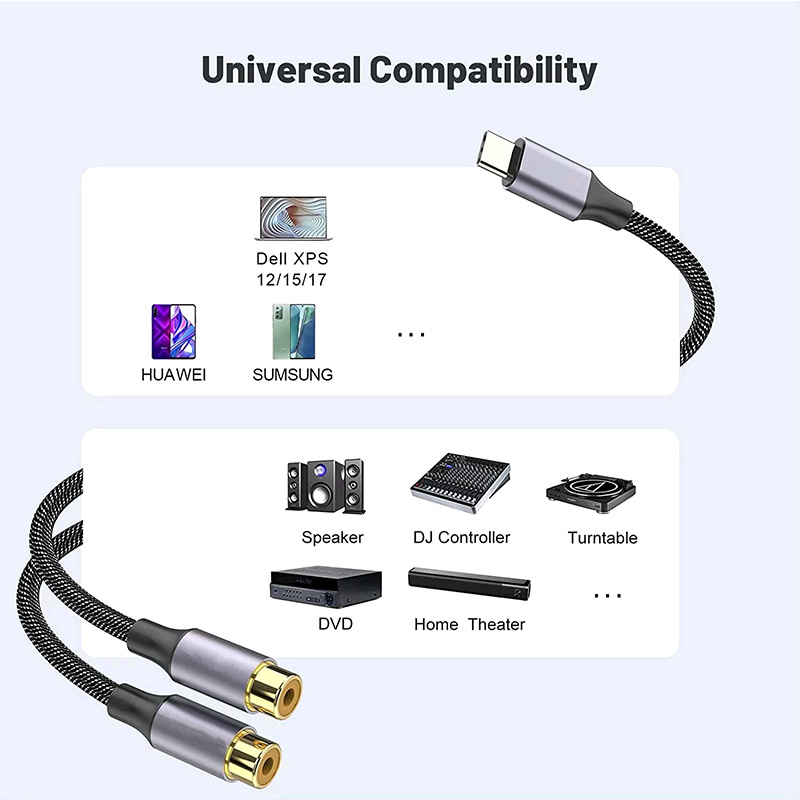In today’s digital world, live streaming has become a crucial part of many industries, from gaming to corporate presentations. One of the most important aspects of live streaming is audio quality, which directly impacts the overall experience. To achieve the best audio output, choosing the right audio cable is essential. This article explores how to customize the perfect audio cable, with a particular focus on Custom Audio Cables and Professional RCA Audio Cables.
Understand the Needs of Your Live Streaming Setup
Before diving into customizing your Custom Audio Cable, it’s important to first understand your live streaming setup and what type of audio you need.
A live streaming setup typically involves a variety of devices: microphones, audio interfaces, mixers, and speakers, all of which require reliable connections. For most professional setups, Professional RCA Audio Cables are often used due to their excellent sound quality and durability. However, customizing a cable to suit your unique requirements can improve performance, such as reducing signal loss, enhancing clarity, and ensuring longevity.
When selecting Custom Audio Cables, it’s essential to consider factors such as the cable length, the type of connectors, and the shielding material. For instance, longer cables might need additional shielding to avoid signal degradation. Similarly, RCA connectors are popular for their versatility and ease of use, making them ideal for many live streaming setups.
In summary, understanding your equipment’s specific needs will allow you to choose the right cable for a clearer, uninterrupted sound.
Choose the Right Cable Type and Connectors for Your Setup
When customizing Custom Audio Cables, one of the first decisions to make is selecting the right type of cable and connectors. For professional live streaming setups, Professional RCA Audio Cables are often the preferred choice, but it’s important to ensure they are customized to match the specifications of your devices.
The most common types of audio cables used in live streaming are XLR, TRS, and RCA. While XLR cables are known for their balanced audio, Professional RCA Audio Cables are typically unbalanced and often used for shorter distances. However, RCA cables are still very popular in live streaming setups due to their affordability and ability to deliver high-quality audio signals.
Customizing the connectors is equally important. For example, RCA connectors can come in various materials such as gold or nickel, which can affect the conductivity and overall sound quality. A customized RCA cable with high-quality connectors can significantly improve the audio experience, ensuring no interference or signal loss during the broadcast.
When selecting your Custom Audio Cables, always ensure that the cable type and connectors align with the equipment you’re using, as this will optimize the overall sound performance.
Prioritize Durability and Flexibility in Custom Cable Design
One of the most important factors when creating Custom Audio Cables for live streaming is durability. Live streaming environments can be demanding, with equipment often being moved or adjusted frequently. Therefore, it’s essential to select cables that can withstand these conditions.
For Professional RCA Audio Cables, choosing materials that resist wear and tear is crucial. Look for cables with strong outer coatings such as PVC or braided cloth, which provide extra protection against cuts, abrasions, and tangling. Additionally, a flexible design is equally important. Cables that are stiff or inflexible can create stress on the connectors, leading to potential failures. A Custom Audio Cable that balances both durability and flexibility will help to maintain high audio performance while also ensuring the longevity of the cable.
Another factor to consider is the environmental conditions where the cable will be used. If you’re streaming in an outdoor environment, you may need to customize your cables with materials that are resistant to moisture or extreme temperatures.
In conclusion, durability and flexibility are key considerations in designing Custom Audio Cables for live streaming. The more resilient the cable, the less chance of signal disruptions or hardware damage during broadcasts.
Consider Cable Length and Signal Integrity
When customizing your Custom Audio Cable, one of the most crucial factors to consider is the cable length. While it may seem like a straightforward choice, the length of the cable can significantly impact signal quality, especially over long distances.
For Professional RCA Audio Cables, longer cables can sometimes cause signal degradation. This results in a loss of audio quality, such as reduced bass response, distorted highs, or even static interference. Therefore, it’s essential to determine the optimal cable length for your setup. In some cases, shorter cables are better as they minimize signal loss and maintain high audio fidelity. However, if longer cables are needed, be sure to choose cables with proper shielding to protect the signal from interference.
Customizing the length of your cable allows you to maintain signal integrity without compromising on sound quality. If you’re using Custom Audio Cables for a mobile live streaming setup, ensure that the cables are not only long enough but also easily coiled or wrapped without causing damage to the internal wiring.
By selecting the right length and ensuring your Custom Audio Cable has proper shielding, you can ensure that your audio remains crisp and clear throughout your live streaming session.
Select Appropriate Shielding for Interference-Free Audio
In any professional audio setup, shielding is a critical factor that directly affects audio performance. For Custom Audio Cables used in live streaming, ensuring that the cables are shielded properly can prevent noise interference and deliver clean audio signals.
In environments with electronic devices, such as computers, cameras, and lighting systems, cables are often exposed to electromagnetic interference (EMI) or radio frequency interference (RFI). This can result in unwanted hums or buzzing in your audio signal. To avoid this, you need Professional RCA Audio Cables that are shielded with materials like foil or braided copper, which block out these interferences.
When customizing your cables, be sure to specify the level of shielding needed based on your environment. For high-interference areas, opting for double shielding or higher-quality materials will give you the best protection against external noise.
In conclusion, investing in proper shielding for your Custom Audio Cables is an essential step to ensure that the audio signal remains clear, professional, and free from any unwanted interference.
Conclusion
Crafting the Perfect Custom Audio Cable for Live Streaming
Customizing the right audio cable for your live streaming setup involves considering several factors, including cable type, connectors, durability, flexibility, length, and shielding. By taking the time to create the perfect Custom Audio Cable, you’ll ensure that your live broadcasts deliver high-quality audio every time. Whether you choose Professional RCA Audio Cables or another option, the key is to select cables that meet the unique needs of your equipment and environment.
By following these tips, you can enhance your live streaming experience, ensuring that your audio setup remains professional, reliable, and clear.

